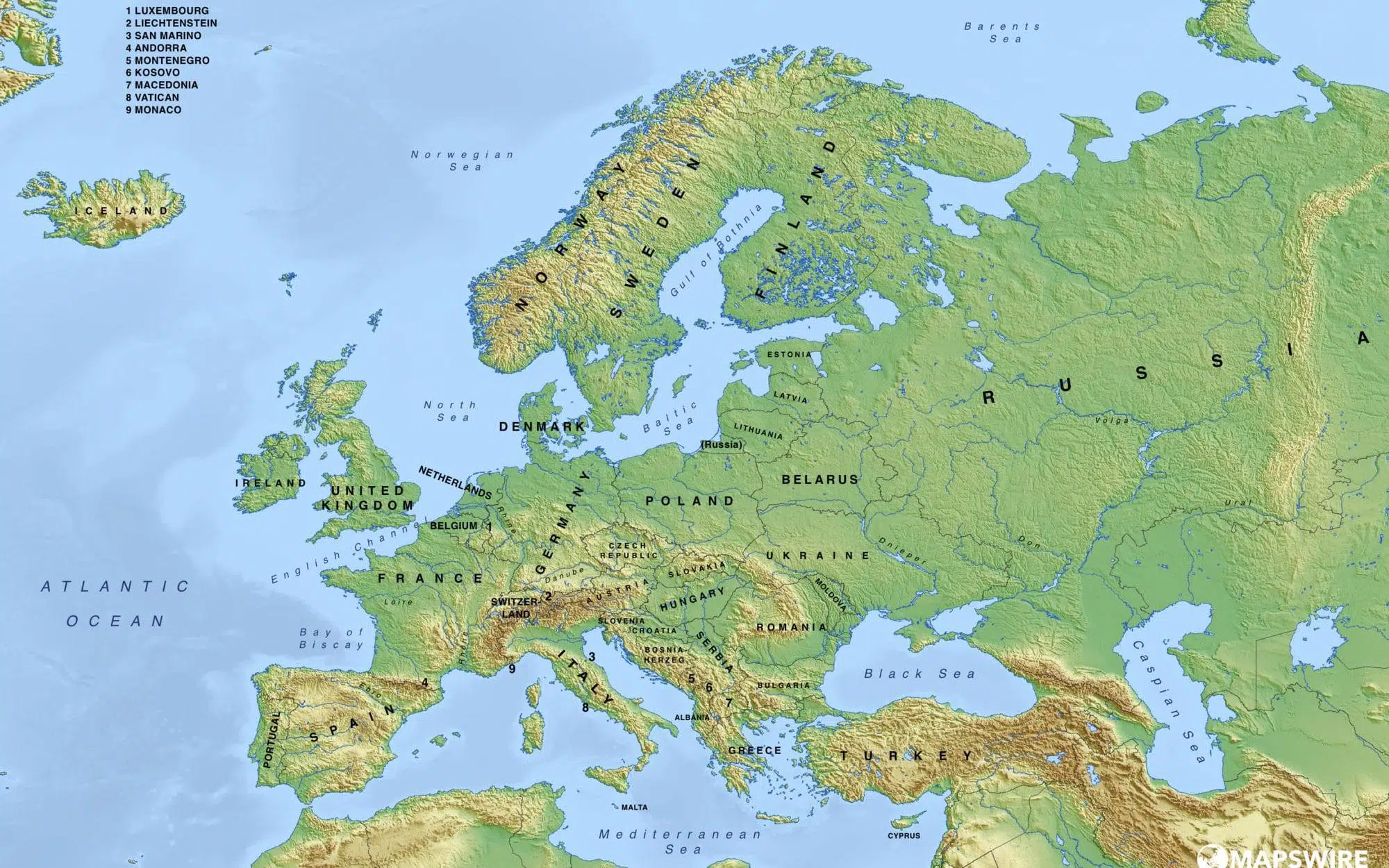What is the Abortion Situation in Europe?
Many American pro-lifers wonder what the long-term impacts of abortion will be on the United States. We have been making significant progress against the Culture of Death over the past decade, but if our progress is reversed and abortion strengthens its hold on our society, what will happen to our country? With Obamacare’s funding of abortions and the related economic problems, what will happen if the abortion rate rises even higher, and we add millions more to the 55 million abortions we have already suffered?
All we have to do to find the answers to these questions is to look East ― to Europe.

The direct cause of abortion is the separation of sex from procreation. Nowhere is this more obvious than in Europe, which has been tightly gripped by the Culture of Death for more than half a century.
The total fertility rate (TFR) of a nation is the average number of children each woman has. This TFR must be about 2.1 in developed nations if they are to achieve replacement level fertility ― meaning that over time the population will remain the same.
Frightening European Demographics
The average TFR of Europe has plunged from an already-low 2.37 children per woman in 1965 to a disastrous 1.33 in 2014, a decline of 44%. The highest 2014 TFR for Europe is Iceland’s 1.83 children per woman, followed by Ireland’s 1.75.
This means that every one of Europe’s 48 nations is currently under replacement fertility levels. Nine European nations have remained continuously below replacement since 1965. The greatest decrease in TFR during the time period 1965‑2014 is Bosnia and Herzegovina’s 69%; not one European nation has increased its TFR from 1965 to 2014.
According to the United Nations Population Information Network, thirty‑two of the fifty lowest TFRs in the world belong to European countries. Bosnia and Herzegovina has the lowest TFR in the world at 0.99 children per family ― this is an average of one child per family, which is less than in China!
22 of the 35 countries in the world whose population is actually declining are located in Europe.
The most populous countries in Europe are Russia with 141,310,000 people (ninth in the world, but rapidly declining); Germany with 82 million; and France, Italy and the United Kingdom, all with about 60 to 65 million.
The only European country with laws that fully protect preborn children or allow for only a “life of the mother” exception is tiny Malta, home to just 0.05% of Europe’s population. Almost all of the other European nations have actual or practical abortion on demand through at least twelve weeks of pregnancy. These nations represent 94% of the total population of Europe.
Economic Impacts of the Culture of Death
The nations of Europe are already feeling the profound economic effects of their longtime anti‑life policies.
Perhaps the most important of these is large imbalances in population age segments, leading to an increased aging of the work force and the population in general. This in turn results in fewer workers supporting more and more retired people every year, creating tremendous pressure on social security systems and retirement plans. It also greatly increases health care costs, leading to a strong push for euthanasia. Already, the Netherlands, Belgium and Switzerland have legalized euthanasia, with assisted suicide “tourism” becoming more common, and the disabled (even infants) being killed without their consent.
Europe has also suffered a great increase in the number of divorces (from 125,000 in 1960 to about 850,000 in 2014); illegitimacy (4.5% of all births in 1960 to about 33% in 2014); unemployment (from five million in 1977 to more than 35 million in 2014); and a huge increase in abortions, to about 4.1 million annually in 2014.1 All of this means that the state must step in and take the place of the fathers of millions of children, since the women are usually left to raise their children by themselves.
This means a staggering increase in the tax burden, shifting funds away from such critical functions as infrastructure maintenance and education.
The population of Muslims in Europe will be about 60 million by 2030, mainly immigrating from North Africa. Because they are generally very religious, Muslims tend to integrate poorly with an aggressively secular European society, a situation causing great tension and conflict that will only worsen in the future. This state of affairs is a direct result of falling Europe birthrates; the last year “native” Europeans replaced themselves was 1973, and since then, there has been a shortfall of tens of millions of births required to replace this population.2
The Eastern European nations have been especially hard-hit by the abortion Holocaust. Russia lost about 12.5% of its population during World War II; it has lost an incredible 61% of its population to abortion (more than 200 million committed since 1963 alone). Bulgaria has lost 42% of its population, Romania has lost 41%, Hungary 30%, and Ukraine and Estonia 28% (by comparison, the United States has lost about 15% of its population to abortion).3
The “Demographic Cross”
The economic future of Europe is in grave doubt. The “demographic cross” feared by many is finally coming to pass.
In the year 1950, Europe was still relatively young and comprised more than a fifth of the world’s population. Meanwhile, Africa was virtually empty, home to less than 10% of the world’s people. But while Africans continued to have large families, Europeans began to abort, sterilize and contracept themselves out of existence. For the first time in history, Europe and Africa had the same population in 1997, with each possessing about one out of every eight of the world’s people. By 2050, the sizes of their populations will have switched places: Africa will have more than one out of every five people, and Europe will have only one out of fourteen. Even more importantly, the average African will be barely 30 years old, while the average European will be 51 years old!4
To whom will the future belong ― to a young, vigorous, large population with huge stores of natural resources, or an old, small, listless population with few such resources?
The answer to that question should be obvious. If it can only overcome its pervasive corruption, Africa will lead the world by the year 2050.
The Effects of Anti-Natalist Propaganda
European population alarmists have been exaggerating the high cost of raising children for decades in their efforts to convince people to have fewer children. Finally, when the baleful demographic effects of too few babies became evident, governments tried to retool the thinking of the people, but with little effect. Every European nation has attempted to bribe its citizens by various means to have more children, with little or no response.
History shows us that once the people of a nation are conditioned to believe they should live only for themselves and that children are a burden, it is virtually impossible to persuade them otherwise. For decades, anti-natalist propaganda has asserted that it costs anywhere from $500,000 to $2.1 million to raise each child.5 Thus, when a government offers a bounty of up to $20,000 to have another child, couples consider this incentive to be laughably inadequate.
This is why the La France a besoin des enfants! [“France needs babies!”] campaign failed.6 And this is why, when the German State of Brandenburg offered to pay its citizens $650 to have a child, there was not even the slightest blip in the birth rate. It is no wonder Wolfgang Jahmer, director of a social welfare program in Schwerin, Germany, said, “We have some fears that the tree of life may be falling.”7
Conclusion
The only solution to this ongoing demographic disaster is for pro‑life activists to convert the hearts and minds of Europeans, one by one. This, unfortunately, will probably take as long to accomplish as the population controllers took to destroy the European’s love of children. But we must think in terms of generations, not years, and continue to work until Europe is once again a shining beacon of hope for the world.
Endnotes
[1] R. Clarke. “Population Imbalances: The Consequences.” Forum [Council of Europe], 1986, pages 5 to 7. The annual numbers of surgical and medical abortions performed in the world are contained in Excel spreadsheet F-18-12, “Annual Number of Legal and Illegal Surgical Abortions performed in the World, 1960-Date.” The annual numbers of abortions for many of the nations of the world are listed in Excel spreadsheet F-20-A, “Annual Legal Abortions Performed in the Nations of the World, 1964-Date.” For either of these spreadsheets, e-mail Brian Clowes at bclowes@hli.org. Unemployment: Eurostat. “Unemployment Statistics.” November 25, 2013.
[2] Calculations and extrapolations based on figures from the Institut National d’Etudes Demographique (INED). “Short Fall in Births Europe.” Population, July/September 1983. On January 1, 2014, the 48 nations of Europe will have a total population of about 738 million people in a land area of 11.3million square kilometers, for an average density of 65 people per square kilometer, a little more than the world average.
[3] For calculations and references, e-mail Brian Clowes at bclowes@hli.org and ask for Excel spreadsheet F-20-A, “Annual Legal Abortions Performed in the Nations of the World, 1964-Date.”
[4] All of the demographic information in this article is from the United Nations Population Information Network (POPIN).
[5] The record for exaggerating the cost of raising a child is probably held by U.S. News and World Report, whose March 30, 1998 issue had on its front cover the headline “The Real Cost of Raising Kids: Would you Believe It’s $1,455,581 Apiece?” Using the consumer price index, this would be about $2.1 million today.
[6] French national ad campaign. Daniela Deane. “Birth Rates Down Across Europe.” USA Today, October 15, 1997.
[7] Stephen Kinzer, New York Times News Service. “German State Pays Bounty for Babies.” The Oregonian, November 25, 1994, page A13.
Did you find this useful?
Dr. Brian Clowes has been HLI’s director of research since 1995 and is one of the most accomplished and respected intellectuals in the international pro-life movement. Best known as author of the most exhaustive pro-life informational resource volume The Facts of Life, and for his Pro-Life Basic Training Course, Brian is the author of nine books and over 500 scholarly and popular articles, and has traveled to 70 countries on six continents as a pro-life speaker, educator and trainer.






